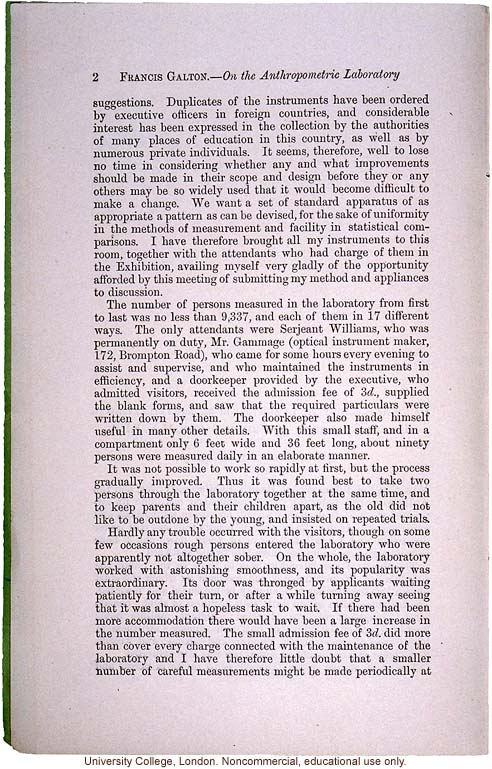2 Francis Galton.-[italics]On the Anthropometric Laboratory[end italics]
suggestions. Duplicates of the instruments have been ordered by executive officers in foreign countries, and considerable interest has been expressed in the collection by the authorities of many places of education in this country, as well as by numerous private individuals. It seems, therefore, well to lose no time in considering whether any and what improvements should be made in their scope and design before they or any others may be so widely used that it would become difficult to make a change. We want a set of standard apparatus of as appropriate a pattern as can be devised, for the sake of uniformity in the methods of measurement and facility in statistical comparisons. I have therefore brought all my instruments to this room, together with the attendants who had charge of them in the Exhibition, availing myself very gladly of the opportunity afforded by this meeting of submitting my method and appliances to discussion.
The number of persons measured in the laboratory from first to last was no less than 9,337, and each of them in 17 different ways. The only attendants were Serjeant Williams, who was permanently on duty, Mr. Gammage (optical instrument maker, 172, Brompton Road), who came for some hours every evening to assist and supervise, and who maintained the instruments in efficiency, and a doorkeeper provided by the executive, who admitted visitors, received the admission fee of 3[italics]d[end italics]., supplied the blank forms, and saw that the required particulars were written down by them. The doorkeeper also made himself useful in many other details. With this small staff, and in a compartment only 6 feet wide and 36 feet long, about ninety persons were measured daily in an elaborate manner.
It was not possible to work so rapidly at first, but the process gradually improved. Thus it was found best to take two persons through the laboratory together at the same time, and to keep parents and their children apart, as the old did not like to be outdone by the young, and insisted on repeated trials.
Hardly any trouble occurred with the visitors, though on some few occasions rough persons entered the laboratory who were apparently not altogether sober. On the whole, the laboratory worked with astonishing smoothness, and its popularity was extraordinary. Its door was thronged by applicants waiting patiently for their turn, or after a while turning away seeing that it was almost a hopeless task to wait. If there had been more accommodation there would have been a large increase in the number measured. The small admission fee of 3[italics]d[end italics], did more than cover every charge connected with the maintenance of the laboratory and I have therefore little doubt that a smaller number of careful measurements might be made periodically at
[end]


